Spring Security 登录时添加图形验证码实现实例
程序员小杰 人气:0前言
在前面的几篇文章中,登录时都是使用用户名 + 密码进行登录的,但是在实际项目当中,登录时,还需要输入图形验证码。那如何在 Spring Security 现有的认证体系中,加入自己的认证逻辑呢?这就是本文的内容,本文会介绍两种实现方案,一是基于过滤器实现;二是基于认证器实现。
验证码生成
既然需要输入图形验证码,那先来生成验证码吧。
加入验证码依赖
<!--验证码生成器-->
<dependency>
<groupId>com.github.penggle</groupId>
<artifactId>kaptcha</artifactId>
<version>2.3.2</version>
</dependency>
<dependency>
<groupId>org.springframework.boot</groupId>
<artifactId>spring-boot-starter-web</artifactId>
</dependency>
Kaptcha 依赖是谷歌的验证码工具。
验证码配置
@Configuration
public class KaptchaConfig {
@Bean
public DefaultKaptcha captchaProducer() {
Properties properties = new Properties();
// 是否显示边框
properties.setProperty("kaptcha.border","yes");
// 边框颜色
properties.setProperty("kaptcha.border.color","105,179,90");
// 字体颜色
properties.setProperty("kaptcha.textproducer.font.color","blue");
// 字体大小
properties.setProperty("kaptcha.textproducer.font.size","35");
// 图片宽度
properties.setProperty("kaptcha.image.width","300");
// 图片高度
properties.setProperty("kaptcha.image.height","100");
// 文字个数
properties.setProperty("kaptcha.textproducer.char.length","4");
//文字大小
properties.setProperty("kaptcha.textproducer.font.size","100");
//文字随机字体
properties.setProperty("kaptcha.textproducer.font.names", "宋体");
//文字距离
properties.setProperty("kaptcha.textproducer.char.space","16");
//干扰线颜色
properties.setProperty("kaptcha.noise.color","blue");
// 文本内容 从设置字符中随机抽取
properties.setProperty("kaptcha.textproducer.char.string","0123456789");
DefaultKaptcha kaptcha = new DefaultKaptcha();
kaptcha.setConfig(new Config(properties));
return kaptcha;
}
}
验证码接口
/**
* 生成验证码
*/
@GetMapping("/verify-code")
public void getVerifyCode(HttpServletResponse resp, HttpSession session) throws IOException {
resp.setContentType("image/jpeg");
// 生成图形校验码内容
String text = producer.createText();
// 将验证码内容存入HttpSession
session.setAttribute("verify_code", text);
// 生成图形校验码图片
BufferedImage image = producer.createImage(text);
// 使用try-with-resources 方式,可以自动关闭流
try(ServletOutputStream out = resp.getOutputStream()) {
// 将校验码图片信息输出到浏览器
ImageIO.write(image, "jpeg", out);
}
}
代码注释写的很清楚,就不过多的介绍。属于固定的配置,既然配置完了,那就看看生成的效果吧!

接下来就看看如何集成到 Spring Security 中的认证逻辑吧!
加入依赖
<dependency>
<groupId>org.springframework.boot</groupId>
<artifactId>spring-boot-starter-security</artifactId>
</dependency>
基于过滤器
编写自定义认证逻辑
这里继承的过滤器为 UsernamePasswordAuthenticationFilter,并重写attemptAuthentication方法。用户登录的用户名/密码是在 UsernamePasswordAuthenticationFilter 类中处理,那我们就继承这个类,增加对验证码的处理。当然也可以实现其他类型的过滤器,比如:GenericFilterBean、OncePerRequestFilter,不过处理起来会比继承UsernamePasswordAuthenticationFilter麻烦一点。
import org.springframework.security.authentication.AuthenticationServiceException;
import org.springframework.security.core.Authentication;
import org.springframework.security.core.AuthenticationException;
import org.springframework.security.web.authentication.UsernamePasswordAuthenticationFilter;
import org.springframework.util.StringUtils;
import javax.servlet.http.HttpServletRequest;
import javax.servlet.http.HttpServletResponse;
import javax.servlet.http.HttpSession;
public class VerifyCodeFilter extends UsernamePasswordAuthenticationFilter {
@Override
public Authentication attemptAuthentication(HttpServletRequest request, HttpServletResponse response) throws AuthenticationException {
// 需要是 POST 请求
if (!request.getMethod().equals("POST")) {
throw new AuthenticationServiceException(
"Authentication method not supported: " + request.getMethod());
}
// 获得请求验证码值
String code = request.getParameter("code");
HttpSession session = request.getSession();
// 获得 session 中的 验证码值
String sessionVerifyCode = (String) session.getAttribute("verify_code");
if (StringUtils.isEmpty(code)){
throw new AuthenticationServiceException("验证码不能为空!");
}
if(StringUtils.isEmpty(sessionVerifyCode)){
throw new AuthenticationServiceException("请重新申请验证码!");
}
if (!sessionVerifyCode.equalsIgnoreCase(code)) {
throw new AuthenticationServiceException("验证码错误!");
}
// 验证码验证成功,清除 session 中的验证码
session.removeAttribute("verify_code");
// 验证码验证成功,走原本父类认证逻辑
return super.attemptAuthentication(request, response);
}
}
代码逻辑很简单,验证验证码是否正确,正确则走父类原本逻辑,去验证用户名密码是否正确。 过滤器定义完成后,接下来就是用我们自定义的过滤器代替默认的 UsernamePasswordAuthenticationFilter。
- SecurityConfig
import cn.cxyxj.study04.Authentication.config.MyAuthenticationFailureHandler;
import cn.cxyxj.study04.Authentication.config.MyAuthenticationSuccessHandler;
import org.springframework.context.annotation.Bean;
import org.springframework.context.annotation.Configuration;
import org.springframework.security.authentication.AuthenticationManager;
import org.springframework.security.config.annotation.web.builders.HttpSecurity;
import org.springframework.security.config.annotation.web.configuration.WebSecurityConfigurerAdapter;
import org.springframework.security.core.userdetails.User;
import org.springframework.security.core.userdetails.UserDetailsService;
import org.springframework.security.crypto.password.NoOpPasswordEncoder;
import org.springframework.security.crypto.password.PasswordEncoder;
import org.springframework.security.provisioning.InMemoryUserDetailsManager;
import org.springframework.security.web.authentication.UsernamePasswordAuthenticationFilter;
@Configuration
public class SecurityConfig extends WebSecurityConfigurerAdapter {
@Bean
PasswordEncoder passwordEncoder() {
return NoOpPasswordEncoder.getInstance();
}
@Bean
@Override
protected UserDetailsService userDetailsService() {
InMemoryUserDetailsManager manager = new InMemoryUserDetailsManager();
manager.createUser(User.withUsername("cxyxj").password("123").roles("admin").build());
manager.createUser(User.withUsername("security").password("security").roles("user").build());
return manager;
}
@Override
@Bean
public AuthenticationManager authenticationManagerBean()
throws Exception {
return super.authenticationManagerBean();
}
@Override
protected void configure(HttpSecurity http) throws Exception {
// 用自定义的 VerifyCodeFilter 实例代替 UsernamePasswordAuthenticationFilter
http.addFilterBefore(new VerifyCodeFilter(), UsernamePasswordAuthenticationFilter.class);
http.authorizeRequests() //开启配置
// 验证码、登录接口放行
.antMatchers("/verify-code","/auth/login").permitAll()
.anyRequest() //其他请求
.authenticated().and()//验证 表示其他请求需要登录才能访问
.csrf().disable(); // 禁用 csrf 保护
}
@Bean
VerifyCodeFilter loginFilter() throws Exception {
VerifyCodeFilter verifyCodeFilter = new VerifyCodeFilter();
verifyCodeFilter.setFilterProcessesUrl("/auth/login");
verifyCodeFilter.setUsernameParameter("account");
verifyCodeFilter.setPasswordParameter("pwd");
verifyCodeFilter.setAuthenticationManager(authenticationManagerBean());
verifyCodeFilter.setAuthenticationSuccessHandler(new MyAuthenticationSuccessHandler());
verifyCodeFilter.setAuthenticationFailureHandler(new MyAuthenticationFailureHandler());
return verifyCodeFilter;
}
}
当我们替换了 UsernamePasswordAuthenticationFilter 之后,原本在 SecurityConfig#configure 方法中关于 form 表单的配置就会失效,那些失效的属性,都可以在配置 VerifyCodeFilter 实例的时候配置;还需要记得配置AuthenticationManager,否则启动时会报错。
- MyAuthenticationFailureHandler
import org.springframework.security.authentication.BadCredentialsException;
import org.springframework.security.authentication.LockedException;
import org.springframework.security.core.AuthenticationException;
import org.springframework.security.web.authentication.AuthenticationFailureHandler;
import javax.servlet.ServletException;
import javax.servlet.http.HttpServletRequest;
import javax.servlet.http.HttpServletResponse;
import java.io.IOException;
import java.io.PrintWriter;
/**
* 登录失败回调
*/
public class MyAuthenticationFailureHandler implements AuthenticationFailureHandler {
@Override
public void onAuthenticationFailure(HttpServletRequest request, HttpServletResponse response, AuthenticationException e) throws IOException, ServletException {
response.setContentType("application/json;charset=utf-8");
PrintWriter out = response.getWriter();
String msg = "";
if (e instanceof LockedException) {
msg = "账户被锁定,请联系管理员!";
}
else if (e instanceof BadCredentialsException) {
msg = "用户名或者密码输入错误,请重新输入!";
}
out.write(e.getMessage());
out.flush();
out.close();
}
}
- MyAuthenticationSuccessHandler
import com.fasterxml.jackson.databind.ObjectMapper;
import org.springframework.security.core.Authentication;
import org.springframework.security.web.authentication.AuthenticationSuccessHandler;
import javax.servlet.ServletException;
import javax.servlet.http.HttpServletRequest;
import javax.servlet.http.HttpServletResponse;
import java.io.IOException;
import java.io.PrintWriter;
/**
* 登录成功回调
*/
public class MyAuthenticationSuccessHandler implements AuthenticationSuccessHandler {
@Override
public void onAuthenticationSuccess(HttpServletRequest request, HttpServletResponse response, Authentication authentication) throws IOException, ServletException {
Object principal = authentication.getPrincipal();
response.setContentType("application/json;charset=utf-8");
PrintWriter out = response.getWriter();
out.write(new ObjectMapper().writeValueAsString(principal));
out.flush();
out.close();
}
}
测试
- 不传入验证码发起请求。
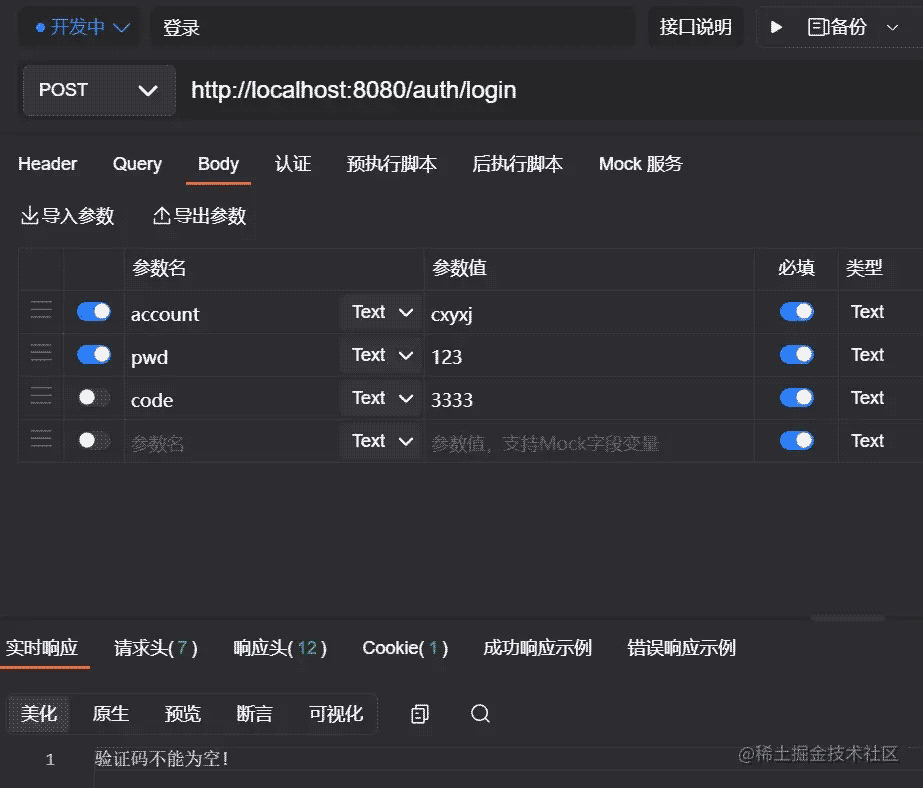
- 请求获取验证码接口
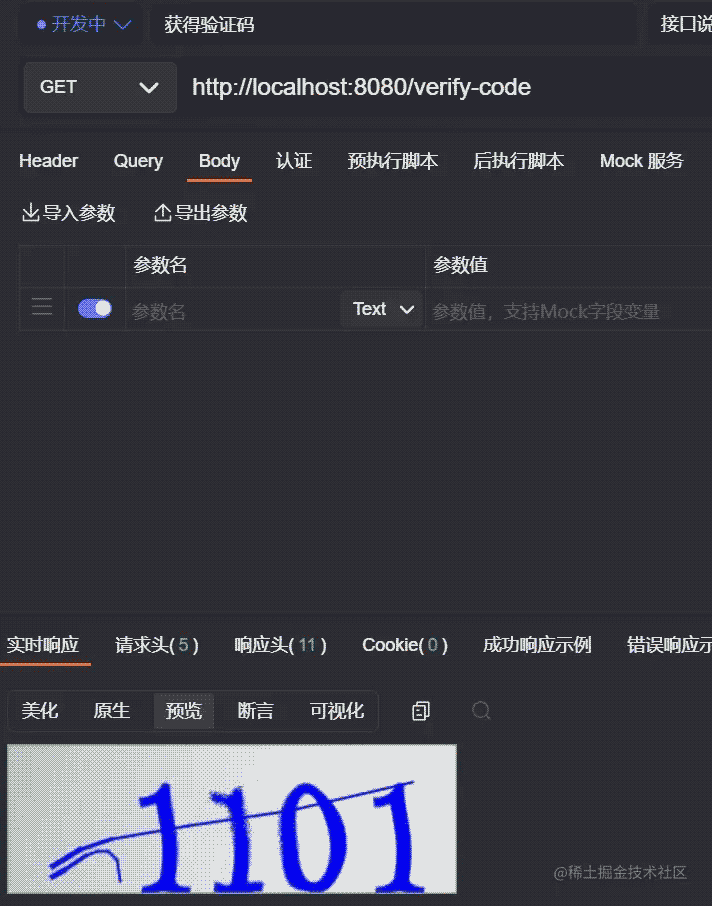
- 输入错误的验证码
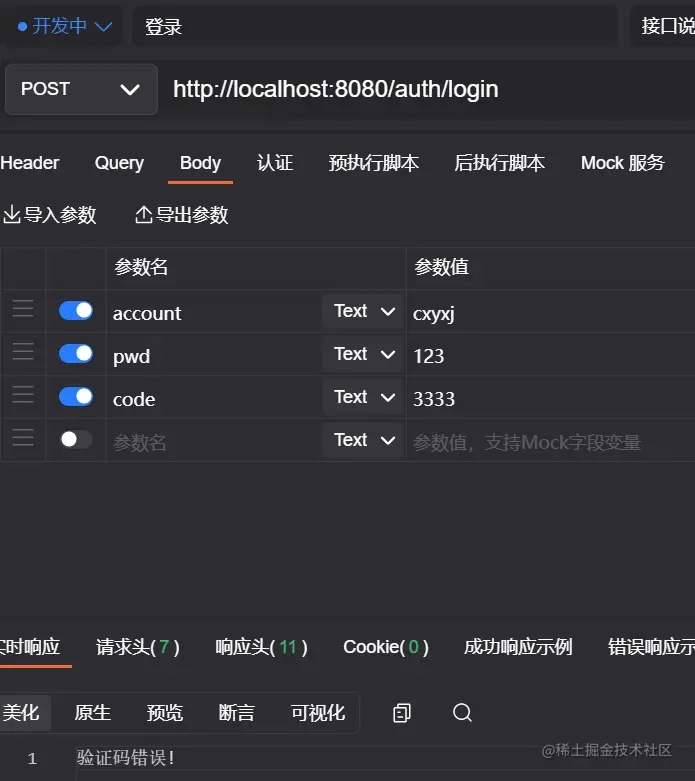
- 输入正确的验证码

输入已经使用过的验证码
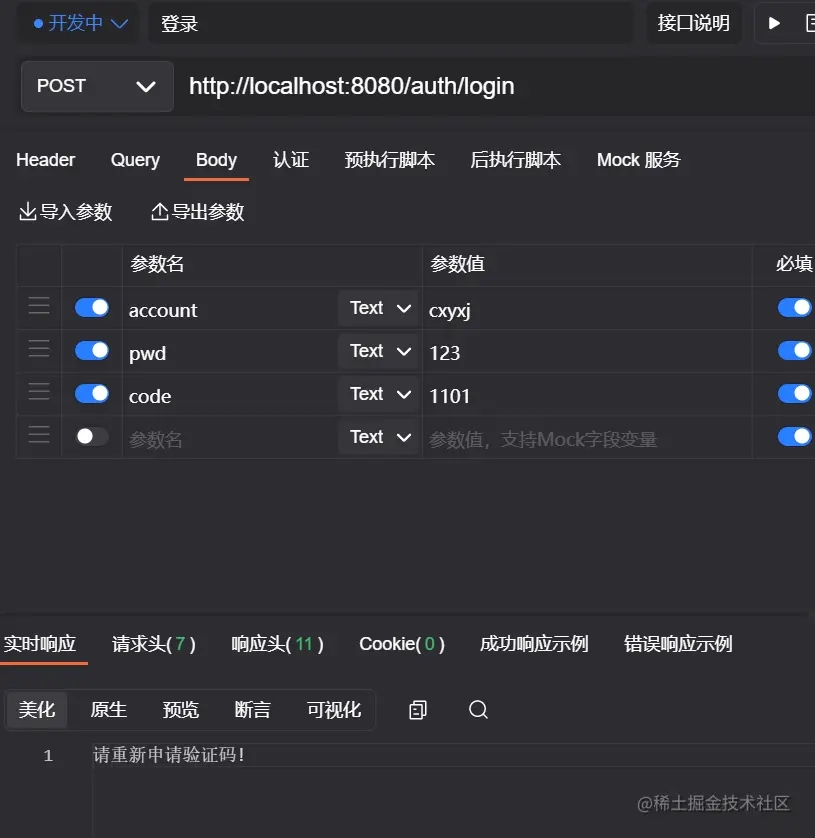
各位读者是不是会觉得既然继承了 Filter,那是不是每个接口都会进入到我们的自定义方法中呀!如果是继承了 GenericFilterBean、OncePerRequestFilter 那是肯定会的,需要手动处理。 但我们继承的是 UsernamePasswordAuthenticationFilter,security 已经帮忙处理了。处理逻辑在其父类 AbstractAuthenticationProcessingFilter#doFilter 中。
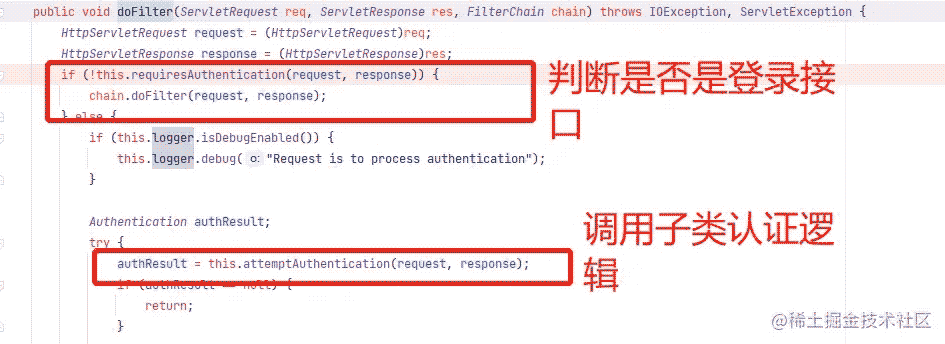
基于认证器
编写自定义认证逻辑
验证码逻辑编写完成,那接下来就自定义一个 VerifyCodeAuthenticationProvider 继承自 DaoAuthenticationProvider,并重写 authenticate 方法。
import org.springframework.security.authentication.AuthenticationServiceException;
import org.springframework.security.authentication.dao.DaoAuthenticationProvider;
import org.springframework.security.core.Authentication;
import org.springframework.security.core.AuthenticationException;
import org.springframework.util.StringUtils;
import org.springframework.web.context.request.RequestContextHolder;
import org.springframework.web.context.request.ServletRequestAttributes;
import javax.servlet.http.HttpServletRequest;
import javax.servlet.http.HttpSession;
/**
* 验证码验证器
*/
public class VerifyCodeAuthenticationProvider extends DaoAuthenticationProvider {
@Override
public Authentication authenticate(Authentication authentication) throws AuthenticationException {
HttpServletRequest req = ((ServletRequestAttributes) RequestContextHolder.getRequestAttributes()).getRequest();
// 获得请求验证码值
String code = req.getParameter("code");
// 获得 session 中的 验证码值
HttpSession session = req.getSession();
String sessionVerifyCode = (String) session.getAttribute("verify_code");
if (StringUtils.isEmpty(code)){
throw new AuthenticationServiceException("验证码不能为空!");
}
if(StringUtils.isEmpty(sessionVerifyCode)){
throw new AuthenticationServiceException("请重新申请验证码!");
}
if (!code.toLowerCase().equals(sessionVerifyCode.toLowerCase())) {
throw new AuthenticationServiceException("验证码错误!");
}
// 验证码验证成功,清除 session 中的验证码
session.removeAttribute("verify_code");
// 验证码验证成功,走原本父类认证逻辑
return super.authenticate(authentication);
}
}
自定义的认证逻辑完成了,剩下的问题就是如何让 security 走我们的认证逻辑了。
在 security 中,所有的 AuthenticationProvider 都是放在 ProviderManager 中统一管理的,所以接下来我们就要自己提供 ProviderManager,然后注入自定义的 VerifyCodeAuthenticationProvider。
- SecurityConfig
import cn.cxyxj.study02.config.MyAuthenticationFailureHandler;
import cn.cxyxj.study02.config.MyAuthenticationSuccessHandler;
import org.springframework.context.annotation.Bean;
import org.springframework.context.annotation.Configuration;
import org.springframework.security.authentication.AuthenticationManager;
import org.springframework.security.authentication.ProviderManager;
import org.springframework.security.config.annotation.web.builders.HttpSecurity;
import org.springframework.security.config.annotation.web.configuration.WebSecurityConfigurerAdapter;
import org.springframework.security.core.userdetails.User;
import org.springframework.security.core.userdetails.UserDetailsService;
import org.springframework.security.crypto.password.NoOpPasswordEncoder;
import org.springframework.security.crypto.password.PasswordEncoder;
import org.springframework.security.provisioning.InMemoryUserDetailsManager;
@Configuration
public class SecurityConfig extends WebSecurityConfigurerAdapter {
@Bean
PasswordEncoder passwordEncoder() {
return NoOpPasswordEncoder.getInstance();
}
@Bean
@Override
protected UserDetailsService userDetailsService() {
InMemoryUserDetailsManager manager = new InMemoryUserDetailsManager();
manager.createUser(User.withUsername("cxyxj").password("123").roles("admin").build());
manager.createUser(User.withUsername("security").password("security").roles("user").build());
return manager;
}
@Bean
VerifyCodeAuthenticationProvider verifyCodeAuthenticationProvider() {
VerifyCodeAuthenticationProvider provider = new VerifyCodeAuthenticationProvider();
provider.setPasswordEncoder(passwordEncoder());
provider.setUserDetailsService(userDetailsService());
return provider;
}
@Override
@Bean
public AuthenticationManager authenticationManagerBean() throws Exception {
ProviderManager manager = new ProviderManager(verifyCodeAuthenticationProvider());
return manager;
}
@Override
protected void configure(HttpSecurity http) throws Exception {
http.authorizeRequests() //开启配置
// 验证码接口放行
.antMatchers("/verify-code").permitAll()
.anyRequest() //其他请求
.authenticated()//验证 表示其他请求需要登录才能访问
.and()
.formLogin()
.loginPage("/login.html") //登录页面
.loginProcessingUrl("/auth/login") //登录接口,此地址可以不真实存在
.usernameParameter("account") //用户名字段
.passwordParameter("pwd") //密码字段
.successHandler(new MyAuthenticationSuccessHandler())
.failureHandler(new MyAuthenticationFailureHandler())
.permitAll() // 上述 login.html 页面、/auth/login接口放行
.and()
.csrf().disable(); // 禁用 csrf 保护
;
}
}
测试
不传入验证码发起请求。
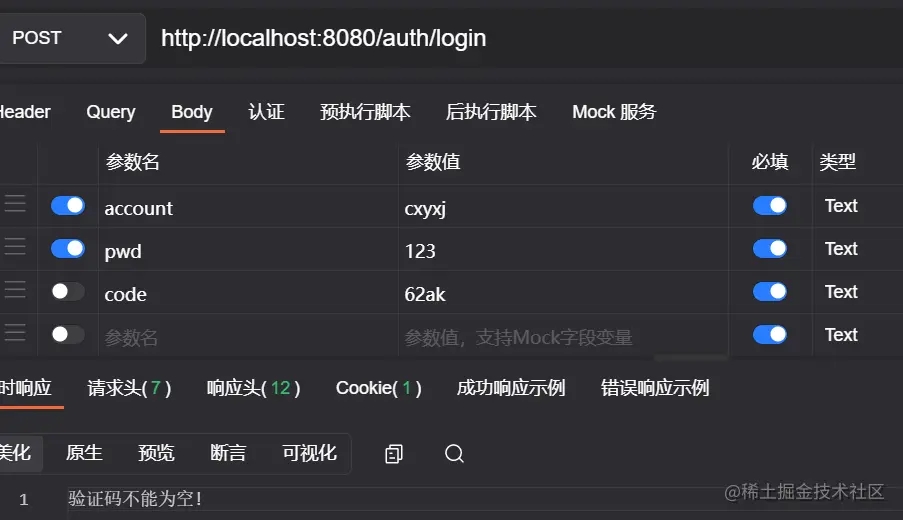
- 请求获取验证码接口
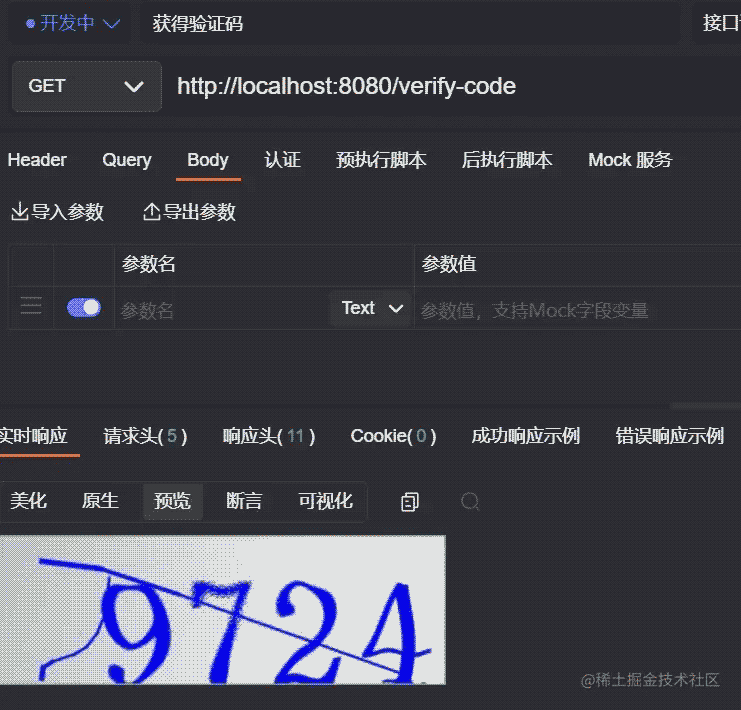
- 输入错误的验证码
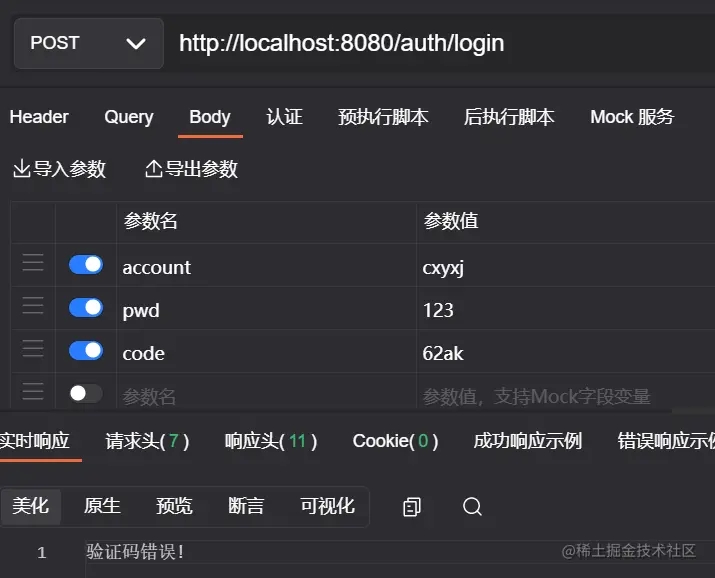
- 输入正确的验证码

- 输入已经使用过的验证码
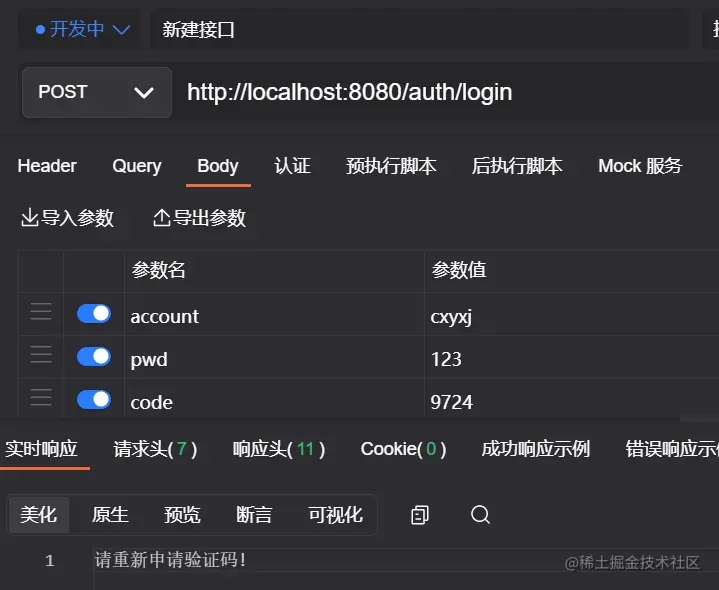
加载全部内容